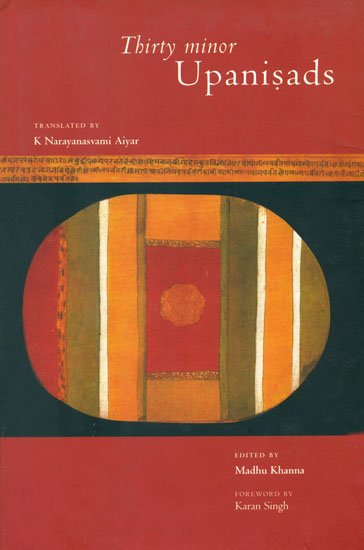Thirty minor Upanishads
by K. Narayanasvami Aiyar | 1914 | 95,228 words
This book contains the English translation of thirty minor Upanishads.—Fourteen belonging to Vedanta, two are categorised as Physiological, three are Mantra, two are Sannyasa and the remaining nine are categorised as Yoga-Upanishads. These Upanishads are properly defined as the Aranya-portion of the Vedas (most ancient Hindu scriptures) and are so-...
Shandilya Upanishad of Atharvaveda, Chapter III
Then Śāṇḍilya questioned Atharvan thus: "From the Brahman that is Om, imperishable, actionless, beneficial, sat (be-ness) only and supreme, how did this universe arise? How does it exist in It? And how is it absorbed in It? Please solve me this doubt."
Atharvan replied: The Supreme Brahman, the Truth, is the imperishable and the actionless. Then from the formless Brahman, three forms (or aspects) arose, (viz.,) niṣkalā (partless,) sakalā (with parts), and sakalā-niṣkalā (with and without parts). That which is satya, vijñāna and ānanda, That which is actionless, without any impurity, omnipresent, extremely subtle, having faces in every direction, undefinable and immortal—that is His niṣkalā aspect. Maheśvara (the great Lord) who is black and yellow rules, with avidyā, mūlaprakṛti or māyā that is red, white, and black, and that is co-existent with Him. This is his sakalā-niṣkalā aspect. Then the Lord desired (or willed) by his spiritual wisdom (thus): May I become many?; may I bring forth? Then from this Person who was contemplating and whose desires are fulfilled, three letters sprang up. Three vyāhṛtis, [1] the three-footed Gāyatrī, [1] the three Vedas, the three devas, the three varṇas (colours or castes) and the three fires sprang. That Supreme Lord who is endowed with all kinds of wealth, who is all pervading, who is situated in the hearts of all beings, who is the Lord of māyā and whose form is māyā—He is Brahma. He is Viṣṇu: He is Rudra: He is Indra: He is all the devas: He is all the bhūtas (elements or beings): He only is before: He only is behind: He only is on our left: He only is on our right: He only is below: He only is above: He only is the all. That form of him as Dattātreya, [2] who sports with his Śakti, who is kind to his devotees, who is brilliant as fire, resembling the petals or a red lotus and is of four hands, who is mild and shines sinlessly—this is His sakalā form."
Then Śāṇḍilya questioned Atharvan, "O Lord, that which is Sat only and the essence of the bliss of consciousness—why is He called Parabrahman?"
Atharvan replied: "Because He increases bṛhati and causes to increase everything (bṛhanti); so he is called Parabrahman. Why is He called Ātmā? Since He obtains (āpnoti) everything, since He takes back everything and since He is everything, so he is called Ātmā. Why is He called Maheśvara (the great Lord)? Since by the sound of the words Mahat-Īśa (the great Lord) and by His own power, the great Lord governs everything. Why is He called Dattātreya? Because the Lord being extremely pleased with Atri (Ṛṣi) who was performing a most difficult penance and who had expressed his desire to see Him who is light itself, offered Himself (datta) as their son, and because the woman Anasūyā was his mother and Atri was his father. Therefore he who knows the (secret) meaning knows everything. He who always contemplates on the supreme that It is himself becomes a knower of Brahman. Here these ślokas (stanzas) occur (to memory). 'He who contemplates always the Lord of Lords and the ancient thus—as Dattātreya, the beneficent, the calm, of the colour of sapphire, one who delights in his own māyā and the Lord who has shaken off everything, as naked and as one whose whole body is besmeared with the holy ashes, who has matted hair, who is the Lord of all, who has four arms, who is bliss in appearance, whose eyes are like full-blown lotus, who is the store of jñāna and yoga, who is the spiritual instructor of all the worlds and who is dear to all the yogins, and one who is merciful towards His devotees, who is the witness of all and who is worshipped by all the siddhas is freed from all sins and will attain (the Spirit).'
"Om Satyam (truth). Thus ends the Upaniṣad."
Footnotes and references:
[1]:
These relate to the Gāyatrī mantras depending upon sound.
[2]:
According to Bhāgavata, he is one of the minor incarnations of Viṣṇu.
